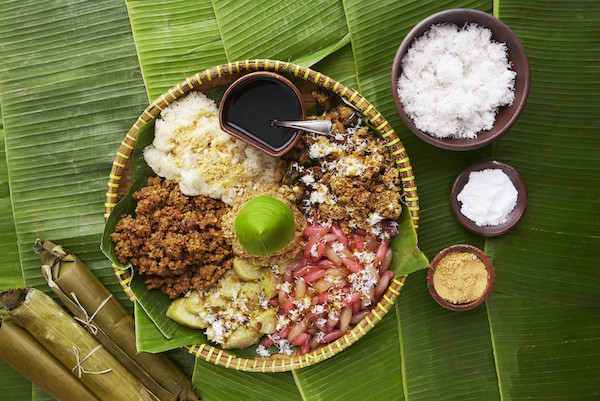Heartfelt stories are main dish in Netflix’s 'Street Food'
Netflix's "Street Food" presents heartfelt stories amid stunning shots of cuisine.
Change Size
 'Jajan pasar' or Javanese market snacks featured in Netflix's 'Street Food'. (Netflix/File)
'Jajan pasar' or Javanese market snacks featured in Netflix's 'Street Food'. (Netflix/File)
C
oming from David Gelb and Brian Mcgann, creators of the acclaimed series Chef’s Table, the first season of Street Food presented roadside vendors in nine Asian cities.
Thailand’s Bangkok, Japan’s Osaka, Taiwan’s Chiayi, the Philippines’ Cebu City and Indonesia’s Yogyakarta are among those featured.
Each episode puts a spotlight on one seller of a beloved and popular dish or joint, interspersed with three or four other coming from the same city. In between, food writers from each country also share their perspectives.
One would expect the same treatment and gestures of Chef’s Table in the new series, and one would not be wrong. The slow-motion, almost erotic shots of foods being prepared, languid scenes of each place and heartfelt stories of how one came to his or her calling in life; they are all there.
The stark difference, however, can be immediately felt in the first episode and it seems to run across nearly all episodes. Most of the cooks featured became “chefs” solely to survive. Economic hardships, family issues and despair served as turning points and selling food to the masses were their attempts for better lives.
Take for instance Jay Fai from Bangkok, whose life was turned upside down by a fire and (much) later received a Michelin star for her crab omelets. Or the cheery, exuberant Toyo from Osaka, whose cooking skills came from a painful childhood.
The sellers were selected based on their stories, as shared by Kevindra Prianto Soemantri, who was among the Indonesians consultants that collaborated with the Street Food team.
“The team mainly looked for stories, the human side of the town’s cultures, struggles and realities. Storytelling became critical, instead of ‘just’ success stories. It eventually came down to how they handled conflicts for decades, and how they became champions of their own lives,” he said in a phone interview with The Jakarta Post.
Kevindra shared that he was approached in May last year, with the team’s initial idea of doing an episode on Jakarta. Along with food expert William Wongso, Kevindra gave another option of Yogyakarta.
“After learning that Bangkok and Singapore were already on the table, we proposed Yogyakarta for different tones,” he said, adding that the team was open to suggestions.
After conducting internet-based and ground research, the team went to the city to film. In Yogyakarta, from eight to 10 food sellers on Kevindra and William’s list, they narrowed the list down to four.
Neither Kevindra nor the team knew about the sellers’ life stories before they came face to face. Therein lies the eliminating process, that the sellers were required to be open, articulate and honest.
Read also: 7 shows on Netflix to watch this Ramadan
“Mbah Satinem was not even on the list initially,” Kevindra said of the jajan pasar (market snack) seller featured in the series.
“Tikka, our local guide in Yogyakarta, was the one who came up with her name. When we found Mbah Satinem, we were instantly fascinated by the way she laughed and how she told her life stories. She was very welcoming and invited us back to her home and kitchen.”
In the series, the elderly figure is seen at her home, waking up at 12 a.m. every day to prepare her dishes along with her husband. In the morning, her daughter helps her get to work. On a sidewalk, chatting with customers, she drizzles lupis (sticky rice) with shredded coconut, palm sugar and her undeniable laughter.
Along with Mbah Satinem, the Yogyakarta episode of Street Food featured Arya Snack & Food, which also sells a variety of jajan pasar, Mbah Lindu (braised jackfruit) and Mie Lethek Cap Garuda (cassava noodles).
For Kevindra the food writer, Street Food also became a turning point. “I realized how the sellers paved through on their own terms,” he said. “Trends or any drama in the food industry hardly mattered to them and yet they stayed real. Surely there’s something to learn from these people, like honesty, being real and staying focused.”
As a documentary, Street Food did its job of presenting delectable cuisine in an artful manner. But also as a documentary, it lacks the thorough history of how each food came to be street food in its respective city or country. Old footage of the cities are wonderful but they offer little in elaborating the insights from these traditions, while the overuse of the words “authentic” and “real” can also make them lose meaning.
The series, however, is clearly a loving tribute to those whose foods we can rely on, who’ve probably shaped our taste buds along the way and whose perseverance is nothing short of captivating.
It’s also worth noting how the music is delightfully suited to the show’s local scene.
For Indonesia, the ending scene features 1970s psychedelic rock band Rasela with the song “Mengedjar Rama-rama”. The singer plainly belts out the song’s lyrics, “I’m so blissfully happy/Chasing butterflies with so many colors/How happy my heart is when I catch them”.
The same words are repeated over and over again, the song is simple and happy. It seems to go wonderfully with how Mbah Satinem has led her life.









